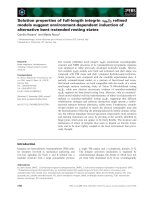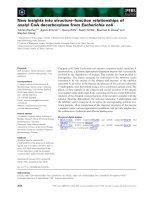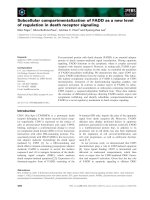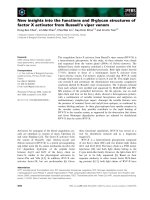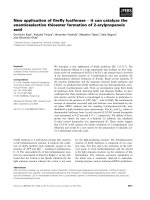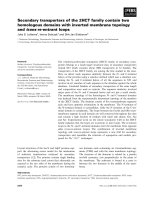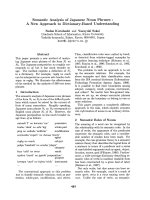Báo cáo khoa học: New application of firefly luciferase ) it can catalyze the enantioselective thioester formation of 2-arylpropanoic acid docx
Bạn đang xem bản rút gọn của tài liệu. Xem và tải ngay bản đầy đủ của tài liệu tại đây (187.86 KB, 9 trang )
New application of firefly luciferase ) it can catalyze the
enantioselective thioester formation of 2-arylpropanoic
acid
Dai-Ichiro Kato
1
, Keisuke Teruya
1
, Hiromitsu Yoshida
1
, Masahiro Takeo
1
, Seiji Negoro
1
and Hiromichi Ohta
2
1 Graduate School of Engineering, University of Hyogo, Japan
2 Department of Biosciences and Informatics, Keio University, Japan
Firefly luciferase is a well-known enzyme that concerns
in the bioluminescence reaction. It catalyzes the oxida-
tion of firefly luciferin with molecular oxygen in the
presence of ATP and Mg
2+
, resulting in luminescence
[1–3]. The stereoselectivity of this bioluminescent reac-
tion was investigated in detail by Seliger et al. [4], who
found that the d-form is the specific substrate for the
light emission reaction whereas the l-form is not used
for the light-producing reaction. The bioluminescence
reaction of firefly luciferase is composed of two reac-
tion steps. The first step is the activation of the carb-
oxyl group to form luciferyladenylate and the second
is the light emission reaction via the oxidation of this
intermediate. The substrate activation mechanism in
the initial step is commonly observed in adenylate-
forming enzymes, such as aminoacyl-tRNA synthetases,
Keywords
acyl-CoA synthetase; enantiomer; firefly
luciferase; kinetic resolution; nonsteroidal
anti-inflamatory drugs
Correspondence
D I. Kato, Graduate School of Engineering,
University of Hyogo, 2167 Shosha, Himeji,
Hyogo 671-2201, Japan
Fax: +81 79 267 4891
Tel: +81 79 267 4969
E-mail:
(Received 22 February 2007, revised 4 June
2007, accepted 5 June 2007)
doi:10.1111/j.1742-4658.2007.05921.x
We introduce a new application of firefly luciferase (EC 1.13.12.7). The
firefly luciferases belong to a large superfamily that includes rat liver long-
chain acyl-CoA synthetase (LACS1). LACS1 is the enzyme that is involved
in the deracemization process of 2-arylpropanoic acid and catalyzes the
enantioselective thioester formation of R-acids. Based on the similarity of
the reaction mechanisms and the sequences between firefly luciferase and
LACS1, we predicted that firefly luciferase also has thioesterification activ-
ity toward 2-arylpropanoic acid. From an investigation using three kinds
of luciferases from North American firefly and Japanese fireflies, we have
confirmed that these luciferases exhibit an enantioselective thioester forma-
tion activity and the R-form is transformed to a thioester in preference to
the S-form in the presence of ATP, Mg
2+
, and CoASH. The enantiomeric
excesses of unreacted recovered acid and thioester were determined by chi-
ral phase HPLC analysis and the resulting 2-arylpropanoyl-CoAs were
identified by high resolution mass spectroscopy. The K
m
and k
cat
values of
thermostable luciferase from Luciola lateralis (LUC-H) toward ketoprofen
were determined as 0.22 mm and 0.11 s
)1
, respectively. The affinity of keto-
profen was almost the same of d-luciferin. In addition, the calculated
E-value toward ketoprofen was approximately 20. These results suggest
that LUC-H could catalyze the kinetic resolution of 2-arylpropanoic acid
efficiently and would be a new option for the preparation of optically act-
ive 2-substituted carboxylic acids.
Abbreviations
ACS, acyl-CoA synthetase; ee, enantiomeric excess; fenoprofen, 2-(3-phenoxyphenyl)propanoic acid; flurbiprofen, 2-(3-fluoro-4-phenyl-
phenyl)propanoic acid; ibuprofen, 2-(4-isobutylphenyl)propanoic acid; ketoprofen, 2-(3-benzoylphenyl)propanoic acid; LACS1, long-chain
acyl-CoA synthetase; LUC-H, thermostable luciferase from Luciola lateralis; naproxen, 2-(6-methoxy-2-naphthyl)propanoic acid; tropic acid,
2-hydroxymethylpropanoic acid.
FEBS Journal 274 (2007) 3877–3885 ª 2007 The Authors Journal compilation ª 2007 FEBS 3877
acyl-CoA synthetases (ACSs), and nonribosomal pep-
tide synthetases (Fig. 1) [5]. In comparison with the
amino acid sequences of firefly luciferases and these
enzymes, it has become apparent that luciferase shares
the most significant similarities with ACSs. In addi-
tion, the crystal structures of Photinus pyralis and
Luciola cruciata luciferases, which were determined by
Conti et al. [6] and Nakatsu et al. [7], respectively,
were confirmed to have the same framework as that of
ACSs. These results indicate that firefly luciferase
evolved from the same ancestral enzymes as ACSs and
acquired a luminescent system in the course of evolu-
tion. The supporting evidence of this hypothesis was
reported by Airth et al. [8]. They showed the bifunc-
tionality of firefly luciferase (i.e. it could catalyze the
thioester formation of dehydroluciferin as well as a
bioluminescent ability). More recently, Oba et al. [9]
found that firefly luciferase also has the ability to form
thioesters of long-chain fatty acids. This report indica-
ted that firefly luciferase also has an acyl-CoA synthe-
tase activity toward an unnatural substrate. In
addition, Nakamura et al. [10] showed that luciferase
exhibits bimodal action depending on the chirality of
luciferin, in that it transforms l-luciferin into luciferyl-
CoA whereas it oxidizes the d-form to oxyluciferin.
In 1990, Suzuki et al. [11] reported that P. pyralis
luciferase showed a significant sequence similarity
with rat liver long-chain acyl-CoA synthetase
(LACS1). LACS1 is the enzyme that is involved in
the deracemization process of 2-arylpropanoic acid
[12,13]. Deracemization is a reaction that inverts the
chirality of either enantiomer of a racemate to the
other antipode, resulting in an optically active com-
pound starting from a racemic mixture. In the case
of rat liver, the deracemization process is realized by
three enzymatic reactions, such as thioesterification,
epimerization, and hydrolysis of the thioester [14]. In
these processes, LACS1 catalyzes the thioesterifica-
tion reaction and this reaction is the only step that
proceeds in an enantioselective manner [15,16]. Thus,
the enantiomeric ratio in the reaction mixture gradu-
ally shifts to one enantiomer with the progression of
the reaction.
The absolute configuration of compounds sometimes
has a strong influence on the biological activity. For
example, 2-arylpropanoic acid constitutes an important
group of physiologically active compounds, because
both enantiomers display different activities in vivo.
The S enantiomers are generally more important
because they are active as nonsteroidal anti-inflamma-
tory drugs [17]. On the other hand, the R enantiomer
of flurbiprofen has recently been paid much attention
because of its anticancer activity as well as a potent
reducer of beta amyloid, the main constituent of amy-
loid plaques in Alzheimer’s disease [18]. Thus, the pre-
paration of optically pure enantiomers is extremely
important and many kinds of enzymatic approaches
have been tried so far [19–21].
In the present study, we examined whether firefly
luciferase has thioesterification activity that can enan-
tiodifferentiate unnatural substrates, such as 2-aryl-
propanoic acid. Based on the similarity of the reaction
mechanisms and the sequences between firefly lucif-
erase and LACS1, we predicted that firefly luciferase
also has thioesterification activity toward 2-arylpropa-
noic acid. From the investigation using three kinds of
luciferases from the North American firefly and Japan-
ese fireflies, we have confirmed that these luciferases
exhibit an enantioselective thioesterification activity
and the R-form is transformed to a thioester in prefer-
ence to the S-form in the presence of ATP, Mg
2+
, and
CoASH.
Fig. 1. Two-step mechanism of adenylate-
forming enzymes, light emission reaction of
firefly luciferase and thioesterification reac-
tion of acyl-CoA synthetase. The initial step
of these enzymatic reactions is the activa-
tion of the carboxyl group to form acyl-
adenylate intermediate. In the case of thio-
esterification reaction, the acyl group is then
transferred to the thiol group of CoASH to
form a thioester (acyl-CoA), whereas light
emission reaction was achieved by a multi-
step oxidation with molecular oxygen of this
intermediate followed by the production of
oxyluciferin.
New application of firefly luciferase D I. Kato et al.
3878 FEBS Journal 274 (2007) 3877–3885 ª 2007 The Authors Journal compilation ª 2007 FEBS
Results and Discussion
Construction of a simple assay system
To confirm whether luciferase could truly catalyze the
enantioselective thioesterification reaction of 2-aryl-
propanoic acid, racemic 2-phenylpropanoic acid, which
has the simplest structure of 2-arylpropanoic acids,
was selected as a substrate and the enantiomeric excess
(ee) of the unreacted acid and thioester were measured
using a chiral phase HPLC column (ee exhibits how
excessive the amount of one enantiomer is compared
to the other in an optically active compound; ee value
can be determined by the equation: ee (%) ¼
|R ) S| ⁄ (R + S) · 100, where R and S are the respect-
ive moles of enantiomers in a compound). The pro-
duced thioester, however, could not be applied to the
chiral phase HPLC column because of its polarity.
Thus, the thioester and unreacted acid had to be separ-
ated before the analysis. To separate these two com-
pounds, a simple protocol was constructed. When the
thioester was produced by the reaction, a large hydro-
philic group was introduced into the molecule as
compared with a hydrophobic benzene ring of the sub-
strate. When the reaction was stopped by hydrochloric
acid, the carboxylate would be protonated to form a
free acid, which would be easily extracted into an
organic layer. On the other hand, the thioester would
remain in the aqueous phase because of the hydrophi-
licity of its structure. Thus, the unreacted acid and the
produced thioester can be separated by a simple
extraction procedure. In addition, if luciferase has an
ability to distinguish the absolute configuration of the
starting material, the ee of the compounds in the two
layers will increase.
After the above mentioned separation procedure, the
ee of the materials in the organic layer was measured.
For this experiment, three kinds of luciferases, P. pylalis
luciferase, L. cruciata luciferase, and thermostable lucif-
erase from Luciola lateralis (LUC-H), were selected.
LUC-H is a mutant enzyme of L. lateralis luciferase,
with improved thermostability and resistance to a kind
of surfactant as compared with the wild-type [22] and it
has been used for hygiene monitoring and biomass
assays based on the ATP-bioluminescence method
[23,24]. In the presence of ATP, Mg
2+
, and CoASH, the
optical purity of the recovered acid increased gradually
to the S-form (Table 1, entries 1–3). In particular, the ee
value exceeded over 35% when the luciferases from Jap-
anese fireflies, L. cruciata and LUC-H, were used. These
results demonstrate that the luciferases of the Japanese
fireflies can differentiate the chirality of 2-phenylpropa-
noic acid, transforming the R-form to a thiol ester with
CoASH. Photinus pyralis firefly, however, exhibits little
enantioselectivity toward this substrate. This result is of
some interest because these three enzymes exhibit signifi-
cant amino acid sequence similarity with each other. As
LUC-H exhibited the highest enantioselectivity toward
2-phenylpropanoic acid, further investigations were
mainly performed using this enzyme.
LUC-H catalyzed kinetic resolution of
2-arylpropanoic acid
To expand the applicability of the present reaction,
other 2-arylpropanoic acids, such as flurbiprofen,
Table 1. Enantioselectivity of firefly luciferase catalyzed thioesterification reaction of 2-arylpropanoic acid. The substrate was incubated at
30 °C for 60 min with LUC-H in the presence of ATP, CoASH and Mg
2+
. The ee of the recovered acid was determined by chiral phase HPLC
analysis; the ee of the thioester was determined by chiral phase HPLC analysis after the hydrolysis of thioester linkage to form the corres-
ponding acid. ND, not detected.
Entry Substrate Origin of luciferase Recovered acid (% ee) Thioester (% ee)
1 2-phenyIpropanoic acid Photinus pyralis 4.6 (S) 6.2 (R)
2 2-phenyIpropanoic acid Luciola cruciata 35.2 (S) 32.2 (R)
3 2-phenyIpropanoic acid LUC-H 42.4 (S) 67.3 (R)
4 Flurbiprofen LUC-H 92.4 (S) 51.9 (R)
6 Iburprofen LUC-H 96.1 (S) 55.1 (R)
6 Ketoprofen Photinus pyralis 44.7 (S) 32.5 (R)
7 Ketoprofen Luciola cruciata 98.0 (S) 52.0 (R)
8 Ketoprofen LUC-H 99.6 (S) 44.6 (R)
9 Naproxen LUC-H 99.6 (S) 69.5 (R)
10 2-phenyIbutanoic acid LUC-H 57.6 (S) 36.0 (R)
11 Tropic acid LUC-H 8.3 (R) > 99.9 (S)
12 2-phenylpentanoic acid LUC-H Racemate ND
13 2-phenyl-3-methylbutanoic acid LUC-H Racemate ND
14 2-(4-chlorophenoxy)propanoic acid LUC-H Racemate ND
15 2-methyl-3-phenylpropanoic acid LUC-H Racemate ND
D I. Kato et al. New application of firefly luciferase
FEBS Journal 274 (2007) 3877–3885 ª 2007 The Authors Journal compilation ª 2007 FEBS 3879
ibuprofen, ketoprofen, and naproxen, were selected
and investigated. These acids constitute an important
group of physiologically active compounds. Although
the enantiomers of these compounds have been already
prepared via lipase catalyzed kinetic resolution and
recrystallization of diastereomeric mixtures, the yield
and the ee of the products are not sufficiently high
[25]. In case of LUC-H catalyzed thioester formation,
however, its enantioselectivity toward these profen
compounds was significantly high and the ee of the
recovered acids were over 90% ee (Table 1, entries 4,
5, 8 and 9). The absolute configuration of the recov-
ered acids was also S, similar to the case of 2-phenyl-
propanoic acid.
Because the ee of the thioesters could not be deter-
mined as they existed, the thioester bond was hydro-
lyzed and the ee of the resulting free acid was measured.
The two kinds of hydrolytic conditions, chemical
hydrolysis under high pH and enzymatic hydrolysis
under neutral pH, were examined, because there was
some fear of racemization by the chemical hydrolysis.
The pK
a
of the a-methine proton of the 2-arylpropa-
noyl-CoA is approximately 10.3 [14] and the pH in the
chemically hydrolyzed reaction mixture was > 10. The
produced acid was extracted by an organic solvent and
its ee was determined by chiral phase HPLC analysis.
Contrary to our expectations, the ee values were almost
the same regardless of the conditions (data not shown).
Based on these results, both hydrolytic methods are
applicable to give free acid from the thioester. In addi-
tion, the enatiomer ratios of these compounds were par-
tial to the R-form. These results give support to the
results of the HPLC analysis of unreacted acids, which
indicate that the thioester formation reaction proceeds
in the R-enantioselective manner (Fig. 2).
Substrate specificity of LUC-H catalyzed thioester
formation
To investigate the substrate tolerance of LUC-H cata-
lyzed thioester formation, the other substrates were
examined (Table 1, entries 10–15). The enantioselective
thioester formation reactions also occurred when the
a-methyl substituent of 2-phenylpropanoic acid was
replaced with an ethyl or hydroxymethyl group. LUC-H
could differentiate the chirality of 2-phenylbutanoic
acid and the ee value of unreacted acid was almost the
same as the case of 2-phenylpropanoic acid. In the
case of 2-hydroxymethylpropanoic acid (tropic acid),
which has a hydroxyl group on the methyl group of
2-phenylpropanoic acid, the thioester was recovered in
enantiomerically pure form, whereas the reaction rate
dramatically decreased. In both cases, enantioselectivi-
ty was almost the same. Unfortunately, however, bul-
kier substitutions could not be used by the enzyme;
2-phenylpentanoic acid and 2-phenyl-3-methylbutanoic
acid were only recovered as racemates and the no
product could be detected in the aqueous phase
(Table 1, entries 12 and 13). In addition, the reaction
did not proceed by the introduction of a spacer
atom between the chiral center and the benzene ring
(Table 1, entries 14 and 15). At present, we have no
idea why LUC-H is not able to use these compounds.
Besides how to distinguish the absolute configuration
of substrates, these results were interesting from the
view point of the molecular recognition of this enzyme.
The 3D structural analysis may shed light on the
answers of these questions.
In the case of recombinant rat LACS1, the substrate
specificity was not investigated in detail and only three
kinds of substrate, ibuprofen, fenoprofen, and flurbi-
profen, were examined [16]. With these substrates,
flurbiprofen could not be used by LACS1. In the case
of LUC-H, however, a series of 2-arylpropanoic acids,
including flurbiprofen, were converted to the corres-
ponding thioesters with good enantioselectivity and
other derivatives were also converted. These results
suggested that LUC-H has a greater potential for
enantioselective thioester formation.
Purification and identification of LUC-H produced
2-arylpropanoyl-CoA
The solid-phase extraction method was used to purify
the thioesters. Purified compounds were subjected to
TLC analysis and the R
f
values of each compound
were in good agreement with the chemically synthes-
ized authentic samples. These were also identified by
the ESI-MS method based on orthogonal TOF-MS.
The mass spectra of 2-arylpropanoyl-CoAs were dom-
inated by ions that agreed with the calculated mass of
singly charged ions of the corresponding thioester. The
results are summarized in Table 2. The detected masses
were within the limit of the accuracy of the instrument
Fig. 2. Luciferase catalyzed enantioselective thioesterification of
2-arylpropanoic acid. LUC-H exhibits an enantioselective thioesterifi-
cation activity and the R-form is transformed to a thioester in pref-
erence to the S-form in the presence of ATP, Mg
2+
, and CoASH.
New application of firefly luciferase D I. Kato et al.
3880 FEBS Journal 274 (2007) 3877–3885 ª 2007 The Authors Journal compilation ª 2007 FEBS
[26]. These results suggested that the purified com-
pounds were definitely 2-arylpropanoyl-CoAs and that
LUC-H is able to catalyze the enantioselevtive thio-
esterification reaction of 2-arylpropanoic acid.
Cofactor requirement experiments were also per-
formed using ketoprofen as the substrate (Table 3).
Based on the ee of the unreacted acids, a dramatical
decrease was observed in the absence of ATP and ⁄ or
CoASH. In addition, no peak of thioester product was
detected in the aqueous layer. These results suggested
that these cofactors were essential for the reaction and
2-arylpropanoyl-CoA was produced by way of an acyl-
adenylate intermediate.
Kinetic analysis of LUC-H catalyzed thioester
formation
The kinetic study of the formation of ketoprofenyl-
CoA catalyzed by LUC-H was examined to obtain the
detailed reaction information. The efficiency of thioest-
er formation was calculated from the peak areas of the
remaining acid and flurbiprofen as an internal stand-
ard using reversed phase HPLC analysis. According to
the Lineweaver–Burk plot, the K
m
and V
max
values for
racemic ketoprofen were 0.22 mm and 110.3 nmolÆ
min
)1
Æmg
)1
protein, respectively (Fig. 3). The k
cat
value was calculated to be 0.11 s
)1
. Because the K
m
value was similar to that of d-luciferin for the
bioluminescence reaction (K
m
¼ 0.15 mm) (the data
are reported in the product data sheet of LUC-H,
which was provided by Kikkoman corporation), keto-
profen and d-luciferin could be bound in the active site
at the same magnitude of affinity. The Michaelis–Men-
ten parameters of recombinant rat LACS1 for the thio-
ester formation were reported by Sevoz et al. [16] and
the values of K
m
and V
max
for (R)-ibuprofen and (R)-
fenoprofen were 1.7 mm, 353 nmolÆmin
)1
Æmg
)1
protein
and 0.10 mm, 267 nmolÆmin
)1
Æmg
)1
protein, respect-
ively. From these data, it seems reasonable to assume
that the specificity of LUC-H and rat LACS1 toward
2-arylpropanoic acid would be almost the same and
hence LUC-H could catalyze the efficient thioester
formation as well as recombinant rat LACS1.
E-value calculation of LUC-H catalyzed thioester
formation
The stereoselectivity of recombinant rat LACS1 was
very high and the complete separation of the absolute
configuration of the substrates was carried out [16]. In
the case of LUC-H, however, the enantioselectivity
was not perfect and the S-form was also converted to
a thioester (data not shown). To confirm the enantio-
selective ratio of LUC-H catalyzed thioesterification of
ketoprofen, the E-value was calculated. The E-value
was used to evaluate the enantioselectivity of enzymat-
ic kinetic resolution and was determined by using the
ee and yield of the unreacted acid according to the
method described by Chen et al. [27]. The calculated
E-values in three conversion points are summarized in
Table 2. Identification of 2-arylpropanoyl-CoA produced by LUC-H
with TOF-MS analysis. For the detection of 2-arylpropanoyl-CoAs
by TOF-MS analysis, see the Experimental procedures section.
Entry Thioester
Predicted
[M-H]
–
Observed
[M-H]
–
Error
(p.p.m.)
1 Flurbiprofenyl-CoA 992.1868 992.1832 )3.63
2 Ibuprofenyl-CoA 954.2275 954.2288 1.40
3 Ketoprofenyl-CoA 1002.1910 1002.1919 0.92
4 Naproxenyl-CoA 978.1011 978.1935 2.43
Table 3. Cofactor requirements analysis for ketoprofenyl-CoA for-
mation by LUC-H. The substrate was incubated at 30 °C for 60 min
with LUC-H. The ee of the recovered acid was determined by chiral
phase HPLC analysis; the ee of the thioester was determined by
chiral phase HPLC analysis after the hydrolysis of thioester linkage
to form the corresponding acid. Relative activity was calculated on
the basis of the ee of recovered acid. ND, not detected.
Entry
Co-factor
Recovered
acid (% ee)
Thioester
(% ee)
Relative
activity (%)
ATP CoASH
1 + + 98.4 80.9 100
2 – + 0.98 ND 1.0
3 + – 0.55 ND 0.6
4 – – 0.62 ND 0.6
Fig. 3. Kinetic study of ketoprofenyl-CoA synthetic activity on
LUC-H. According to the Lineweaver–Burk plot, the K
m
, V
max
and
k
cat
values for racemic ketoprofen were 0.22 mM, 110.3 nmolÆ
min
)1
Æmg
)1
protein, and 0.11 s
)1
, respectively.
D I. Kato et al. New application of firefly luciferase
FEBS Journal 274 (2007) 3877–3885 ª 2007 The Authors Journal compilation ª 2007 FEBS 3881
Table 4. There are little changes for each conversion
point. This result exhibits that the produced thioester
does not affect the enantioselectivity of the enzyme
and the R-acid would be converted to a thioester
approximately 20 times faster than the S-acid.
pH profile of LUC-H catalyzed thioester formation
The activity-pH profile of the LUC-H catalyzed thio-
esterification reaction of ketoprofen over a wide range
is shown in Fig. 4. The enzyme was highly active in the
alkaline pH region with the maximum activity at
pH 9–10. In the pH range over 10, the apparent enzy-
matic activities were reduced markedly. This is because
of the spontaneous hydrolysis of the thioester linkage.
In comparison with the bioluminescence reaction, the
enzyme kept its activity for thioester formation in a
wider range of pH and the optimal shifted to the basic
region.
Thioesterification acitivity of L. cruciata and
P. pyralis luciferases
From the above experiments (Table 1, entries 1–3), it
was known that L. cruciata and P. pyralis luciferases
also have an ability to catalyze the enantioselective
thioesterification of 2-arylpropanoic acid, although
with selectivity inferior to that of LUC-H. To disclose
whether these luciferases have an ability to catalyze
the enantioselective thioester formation toward other
compounds, these enzymes were analyzed. Ketoprofen
was used as a substrate. Fortunately, those two
luciferases exhibited the enantioselective thioester
formation activity (Table 1, entries 6 and 7). The
enantiopreference of these enzymes was the R-form,
similarly to the case of LUC-H. The reaction effi-
ciency of L. cruciata luciferase is the same level as
LUC-H. In addition, P. pyralis luciferase could also
differentiate between the enantiomers of the substrate.
The produced thioester was also isolated by the solid-
phase extraction method and the mass value of the
purified thioester was consistent with the calculated
value of ketoprofenyl-CoA. In the case of P. pyralis
luciferase, the E-value was calculated as 16. This
result suggested that the enantioselectivity of P. pyral-
is luciferase toward ketoprofen was the same as
that of LUC-H, although the selectivity toward
2-phenylpropanoic acid was quite different from each
other.
Conclusions
We found a unique method for the preparation of
optically active 2-arylpropanoic acid using a biolumin-
escence enzyme. Based on the similarity of the reaction
mechanisms and the sequences between firefly lucif-
erase and rat LACS1, we predicted that firefly luciferase
would have an enzymatic activity of enantioselevtive
thioester formation. The three kinds of luciferases
from the North American firefly and Japanese fireflies
exhibit an enantioselective thioesterification activity
toward 2-arylpropanoic acid and the R-form is trans-
formed to a thioester in preference to the S-form in
the presence of ATP, Mg
2+
, and CoASH. The produc-
tion of 2-arylpropanoyl-CoAs was confirmed by the
high accuracy exact mass measurements by TOF-MS
analysis. Thermostable luciferase from L. lateralis
(LUC-H) exhibited thioesterification activity in high
efficiency and the ee of unreacted recovered acid and
thioester were relatively high. The K
m
and k
cat
values
toward racemic ketoprofen were determined as
0.22 mm and 0.11 s
)1
, respectively, and the E-value for
this substrate was calculated to be 20. These results
Table 4. Determination of enantioselectivity (E-value) for ketoprofen
by LUC-H catalyzed thioester formation. The substrate was incuba-
ted at 30 °C for 60 min with LUC-H. Conversion was calculated from
the yield of recovered acid. Yield of the recovered acid was
determined by the reversed phase HPLC analysis in the presence
of flurbiprofen as an internal standard. ee of the recovered acid was
determined by chiral phase HPLC analysis. E-value was
calculated based on the conversion (c) and ee of the recovered
acid (ee(s)) according to the equation: E ¼ ln[(1 ) c)(1 ) ee(s))] ⁄
ln[(1 ) c)(1 + ee(s))] [27].
Entry
Conversion
(%)
Recovered
acid (% yield)
ee
(%) E -value
1 24.7 75.3 28.8 20
2 39.0 61.0 53.5 19
3 61.8 38.2 99.6 24
Fig. 4. pH activity profile of LUC-H catalyzed thioester formation
(s) and bioluminescent reaction (d). The activity of thioester forma-
tion was determined by the comparison with the initial velocity of
the reaction.
New application of firefly luciferase D I. Kato et al.
3882 FEBS Journal 274 (2007) 3877–3885 ª 2007 The Authors Journal compilation ª 2007 FEBS
suggested that LUC-H can be used for the kinetic
resolution of 2-arylpropanoic acid and will be the new
choice for the preparation of optically active 2-substi-
tuted carboxylic acids.
Experimental procedures
General methods
All chemicals were commercially available and used without
further purification unless otherwise noted. Analytical TLC
was developed on E. Merck Silica Gel 60 F
256
plates
(0.25 mm thickness). Firefly luciferases from P. pyralis
and recombinant luciferase from L. cruciata were purchased
from Sigma (St Louis, MO, USA) and Wako (Osaka,
Japan), respectively. Thermostable luciferase from
L. lateralis (LUC-H) was thankfully gifted from Kikkoman
Corporation (Tokyo, Japan). HPLC analysis was carried
out with a Shimazu liquid chromatograph (LC-20AT) or
CO-8020 (Toso Co., Ltd, Tokyo, Japan). Mass spectra were
recorded on a Waters Flight Mass Spectrometer LCT-Pre-
mier (Waters Corp., Milford, MA, USA). Centrifugation
was carried out by high speed refrigerated microcentrifuges
(TOMY, Tokyo, Japan) with TMP-11 rotor. Protein con-
centration was determined by the method of Bradford [28]
with the protein assay kit (Bio-Rad Laboratories, Inc.,
Hercules, CA, USA) and BSA was used as the standard.
Authentic samples of 2-arylpropanoyl-CoA were chemically
synthesized according to the described method [29]. The
tesB gene of Escherichia coli JM109 was cloned into the
NdeI and XhoI sites of pET23C(+) vector by the standard
procedure and the resulting plasmid, pTesB, was trans-
formed into E. coli BL21(DE3). The induction of tesB
protein expression was performed by the addition of
0.5 mm IPTG at 25 °C in Luria–Bertani medium containing
50 mgÆmL
)1
of ampicillin.
Luciferase catalyzed kinetic resolution of
2-arylpropanoic acid
To 100 mm potassium phosphate buffer (pH 7.0), racemic
2-arylpropanoic acid (0.25 mm), ATP (10 mm), CoASH
(2 mm), and MgCl
2
(10 mm) were added. The final volume
of the reaction mixture was adjusted to 500 lL. The mix-
ture was preincubated at 30 °C for 10 min. The reaction
was started by the addition of the appropriate amount of
firefly luciferase (10–1000 lg protein) and incubated at
30 °C for 60 min. After adding 100 lLof2m HCl and
1 mL of diethyl ether to the reaction, the mixture was sha-
ken and centrifuged at 17 610 g for 10 min. The separated
organic layer was concentrated in vacuo and the ee was an-
alyzed by HPLC with a Daicel Chiral column (Daicel
Chemical Industries Ltd, Tokyo, Japan) using a mixture of
hexane ⁄ 2-propanol ⁄ trifluoroacetic acid in an appropriate
proportion as the eluent.
The ee of the thioester in the aqueous layer was deter-
mined after hydrolysis of the thioester linkage. Two kinds of
hydrolytic conditions were examined: chemical hydrolysis,
using 120 lLof2m NaOH incubation at room temperature
for 30 min, and enzymatic hydrolysis, using residual aque-
ous layer neutralized to pH 7 by addition of 2 m NaOH and
100 lL of cell free extract of tesB overexpressed E. coli and
incubation at 30 °C for 30 min. After the hydrolysis, the
reaction was quenched by adding 120 lLof2m HCl and
1000 lL of diethyl ether. The mixture was shaken and cen-
trifuged at 17 610 g for 10 min. The separated organic layer
was concentrated in vacuo and the ee was analyzed by HPLC
with a Daicel Chiral column.
The conditions and results of HPLC analysis were: for
2-phenylpropanoic acid, Daicel Chiralcel OD-H column
(hexane ⁄ 2-propanol ⁄ trifluoroacetic acid ¼ 100 ⁄ 1 ⁄ 0.1%, 1.0
mLÆmin
)1
, 210 nm), t
R
26.5 min (R-form) and 32.5 min
(S-form); for flurbiprofen, Daicel Chiralcel OD-H column
(hexane ⁄ 2-propanol ⁄ trifluoroacetic acid ¼ 100 ⁄ 1 ⁄ 0.1%,
1.0 mLÆmin
)1
, 210 nm), t
R
31.9 min (R-form) and 37.1 min
(S-form); for ibuprofen, Daicel Chiralcel OD-H column (hex-
ane ⁄ 2-propanol ⁄ trifluoroacetic acid ¼ 100 ⁄ 1 ⁄ 0.1%, 1.0 mLÆ
min
)1
, 210 nm), t
R
15.7 min (R-form) and 18.3 min
(S-form); for ketoprofen, Daicel Chiralcel OJ-H column (hex-
ane ⁄ 2-propanol ⁄ trifluoroacetic acid ¼ 95 ⁄ 5 ⁄ 0.1%, 1.0 mLÆ
min
)1
, 254 nm), t
R
39.7 min (R-form) and 50.2 min
(S-form); for naproxen: Daicel Chiralcel OD H column (hex-
ane ⁄ 2-propanol ⁄ trifluoroacetic acid ¼ 95 ⁄ 5 ⁄ 0.1%, 0.5 mLÆ
min
)1
, 254 nm), t
R
23.3 min (R-form) and 27.4 min
(S-form); for 2-phenylbutanoic acid, Daicel Chiralcel
OD-H column (hexane ⁄ 2-propanol ⁄ trifluoroacetic acid ¼
100 ⁄ 1 ⁄ 0.1%, 1.0 mLÆmin
)1
, 210 nm), t
R
20.0 min (R-form)
and 28.4 min (S-form); for tropic acid, Daicel Chiralcel
OD-H column (hexane ⁄ 2-propanol ⁄ trifluoroacetic acid ¼
95 ⁄ 5 ⁄ 0.1%, 1.0 mLÆmin
)1
, 254 nm), t
R
20.9 min (S-form)
and 25.9 min (R-form); for 2-phenylpentanoic acid: Daicel
Chiralcel OD-H column (hexane ⁄ 2-propanol ⁄ trifluoroacetic
acid ¼ 100 ⁄ 1 ⁄ 0.1%, 1.0 mLÆmin
)1
, 210 nm), t
R
17.9 min
(R-form) and 23.6 min (S-form); for 2-phenyl-3-methylbuta-
noic acid: Daicel Chiralcel OD-H column (hexane ⁄ 2-
propanol ⁄ trifluoroacetic acid ¼ 100 ⁄ 1 ⁄ 0.1%, 1.0 mLÆmin
)1
,
210 nm), t
R
16.3 min (R-form) and 25.0 min (S-form); for
2-(4-chlorophanoxy)propanoic acid: Daicel Chiralcel OJ-H
column (hexane ⁄ 2-propanol ⁄ trifluoroacetic acid ¼ 95 ⁄ 5 ⁄
0.1%, 1.0 mLÆmin
)1
, 254 nm), t
R
15.4 min (R-form) and
19.0 min (S-form); for 2-methyl-3-phenylpropanoic acid,
Daicel Chiralcel OJ-H column (hexane ⁄ 2-propanol ⁄ tri-
fluoroacetic acid ¼ 95 ⁄ 5 ⁄ 0.1%, 0.5 mLÆmin
)1
, 254 nm), t
R
20.0 min (R-form) and 22.4 min (S-form).
Purification and identification of
2-arylpropanoyl-CoA
2-Arylpropanoyl-CoA thioester was purified by solid-
phase extraction cartridges (Chromabond C 18 ec,
D I. Kato et al. New application of firefly luciferase
FEBS Journal 274 (2007) 3877–3885 ª 2007 The Authors Journal compilation ª 2007 FEBS 3883
Macherey-Nagel, Du
¨
ren, Germany) [30]. After the prepar-
ation of the aqueous layer as described above, reaction mix-
ture was neutralized by the addition of 2 m NaOH and
ammonium acetate was added to a final concentration of
520 mm. After cartridge preconditioning with consecutive
washing with methanol, water, and 520 mm ammonium
acetate solution (3 mL each), the mixture was loaded onto
the cartridge. The column was rinsed with 5 mL of 520 mm
ammonium acetate solution to remove free CoASH. The
thioester was recovered by elution with 5 mL of distilled
water. The eluates were lyophilized and resolved in a small
amount of water. Fractions containing the thioester, which
were identified with delayed nitroprusside reaction [31],
were checked by TLC and TOF-MS analysis. TLC was
performed on silica gel plates using the solvent system of
1-butanol ⁄ water ⁄ acetic acid (60 ⁄ 35 ⁄ 25) and R
f
values of
0.57, 0.56, 0.55, and 0.56 were observed for flurbiprofenyl-
CoA, ibuprofenyl-CoA, keoprofenyl-CoA, and naproxe-
noyl-CoA, respectively. Purified thioesters were subjected to
ESI-TOF-MS with an LCT-Premier (Waters Corp.). The
data were acquired in the negative ESI mode and leucine
enkephalin was selected as a reference compound for high
accuracy exact mass measurements.
Kinetic analysis
To 100 mm potassium phosphate buffer (pH 7.0), racemic
ketoprofen (0.04–1.0 mm), ATP (10 mm), CoASH (2 mm),
and MgCl
2
(10 mm) were added. The final volume of the
reaction mixture was adjusted to 500 lL. The mixture was
preincubated at 30 °C for 10 min. The reaction was started
by the addition of LUC-H (28.5 lg protein) and incubated
at 30 °C for 10 min. After adding 100 lLof2m HCl and
1000 lL of diethyl ether to the reaction, the mixture was
shaken and centrifuged at 17 610 g for 10 min. The separ-
ated organic layer was concentrated in vacuo. The yield of
the unreacted carboxylic acid was measured by reversed-
phase HPLC using a Mightysil RP-18GP Aqua 250–4.6
(5 lm) (Kanto Corp., Tokyo, Japan) with an isocratic
solvent system of water ⁄ acetonitrile ⁄ trifluoroacetic acid
(2 ⁄ 3 ⁄ 0.05%) at a flow rate of 0.5 mLÆmin
)1
at 35 °C. The
fractions from the column were monitored at 254 nm and
flurbiprofen was used as an internal standard. Retention
times of ketoprofen and flurbiprofen were 9.5 min and
13.2 min, respectively. Each assay was performed eight
times. The kinetic parameters for racemic ketoprofen were
determined by the method of Lineweaver–Burk plots.
E-value calculations
The reaction condition was the same as the kinetic analysis,
except that 140 lg protein of LUC-H was used for this
study. Each assay was performed three times. The E-value
was calculated from the ee and yield of the unreacted acid
according to a previously described method [27].
pH profile experiments
The thioester formation activity was determined in the
following buffers (100 mm): citric acid–sodium citrate
buffer (pH 3.0–4.0), succinate–KOH buffer (pH 4.0–5.5),
Me–KOH buffer (pH 5.5–7.0), potassium phosphate buffer
(pH 7.0–8.0), Tris ⁄ HCl buffer (pH 8.0–10.0), sodium car-
bonate–sodium hydrogen carbonate buffer (pH 10.0–11.5).
The reaction condition was the same as the kinetic analysis,
except that other buffer system and 280 lg protein was
used for this experiment. Each assay was performed three
times and the initial velocity of the thioester formation was
determined at each pH. Relative activity was calculated
from the comparison of these velocities.
Acknowledgements
This work was partially received the financial support
from a Kawanishi Memorial Shinmaywa Education
Foundation. DK greatly acknowledges the helpful sup-
port of Mr Mikio Bakke of Kikkoman Corporation.
References
1 McElroy WD & Green A (1956) Function of adenosine
triphosphate in the activation of luciferin. Arch Biochem
Biophys 64, 257–271.
2 Rhodes WC & McElroy WD (1958) Enzymatic synthe-
sis of Adenyl-oxyluciferin. Science 128, 253–254.
3 Rhodes WC & McElroy WD (1958) The synthesis and
function of luciferyl-adenylate and oxyluciferyl-adeny-
late. J Biol Chem 233, 1528–1537.
4 Seliger HH, McElroy WD, White EH & Field GF
(1961) Stereospecificity and firefly bioluminescence. A
comparison of natural and synthetic luciferins. Proc Nat
Acad Sci USA 47, 1129–1134.
5 McElroy WD, DeLuca M & Tavis J (1967) Molecular
uniformity in biological catalyses. Science 157, 150–160.
6 Conti E, Franks NP & Brick P (1996) Crystal structure
of firefly luciferase throws light on a superfamily of
adenylate-forming ezymes. Sructure 4, 287–298.
7 Nakatsu T, Ichiyama S, Hiratake J, Saldanha A, Koba-
shi N, Sakata K & Kato H (2005) Structural basis for
the spectral difference in luciferase bioluminescence.
Nature 440, 372–376.
8 Airth RL, Rhodes WC & McElroy WD (1958) The
function of coenzyme A in luminescence. Biochim Bio-
phys Acta 27, 519–532.
9 Oba Y, Ojika M & Inouye S (2003) Firefly luciferase is
a bifunctional enzyme: ATP-dependent monooxygenase
and a long chain fatty acyl-CoA synthetase. FEBS Lett
540, 251–254.
10 Nakamura M, Maki S, Amano Y, Ohkita Y, Niwa K,
Hirano T, Ohmiya Y & Niwa H (2005) Firefly luciferase
New application of firefly luciferase D I. Kato et al.
3884 FEBS Journal 274 (2007) 3877–3885 ª 2007 The Authors Journal compilation ª 2007 FEBS
exhibits bimodal action depending on the luciferin
chirality. Biochem Biophys Res Commun 331, 471–475.
11 Suzuki H, Kawarabayashi Y, Kondo J, Abe T,
Nishikawa K, Kimura S, Hashimoto T & Yamamoto T
(1990) Structure and regulation of rat long-chain acyl-
CoA synthetase. J Biol Chem 256, 8681–8685.
12 Knihinicki RD, Williams KM & Day RO (1989) Chiral
inversion of 2-arylpropionic acid nonsterpodal anti-
inflammatory drugs ) 1. In vitro studies of ibuprofen
and flurbiprofen. Biochem Pharmacol 38, 4389–4395.
13 Hall SD & Xiaotao Q (1994) The role of coenzyme A in
the biotransformation of 2-arylpropionic acids. Chem
Biol Interact 90, 235–251.
14 Shieh W-R & Chen C-S (1993) Purification and Charac-
terization of novel ‘2-arylpropionyl-CoA epimerases’
from rat liver cytosol and mitochondria. J Biol Chem
268, 3487–3493.
15 Brugger R, Reichel C, Alia BG, Brune K, Yamamoto T,
Tegeder I & Geissinger G (2001) Expression of rat liver
long-chain acyl-CoA synthetase and characterization of
its role in the metabolism of R-ibuprofen and other fatty
acid-like xenobiotics. Biochem Pharmacol 61, 651–656.
16 Sevoz C, Benoit E & Buronfosse T (2000) Thioesterifica-
tion of 2-arylpropionic acids by recombinant acyl-coen-
zyme A synthetases (ACS1 and ACS2). Drug Metab
Dispos 28, 398–402.
17 Hutt AJ & Caldwell J (1984) The importance of stereo-
chemistry in the clinical pharmacokinetics of the 2-aryl-
propionic acid non-steroidal anti-inflammatory drugs.
Clin Pharmacokinet 1984, 371–373.
18 Morihara T, Chu T, Ubeda O, Beech W & Cole GM
(2002) Selective inhibition of Abeta42 production by
NSAID R-enantiomers. J Neurochem 83, 1009–1012.
19 Faber K (2004) Biotransformations in Organic Chem-
istry, 5th edn. Springer-Verlag, Berlin.
20 Drauz K & Waldman H (2002) Enzyme Catalysis in
Organic Synthesis: a Comprehensive Handbook, 2nd edn.
VHC, Weinheim.
21 Wong C-H & Whitesides GM (1994) Enzymes in
Synthetic Organic Chemistry. Pergamon, Oxford.
22 Hattori N, Kajiyama N, Maeda M & Murakami S
(2002) Mutant luciferase enzymes from fireflies with
increased resistance to benzalkonium chloride. Biosci
Biotechnol Biochem 66, 2587–2593.
23 Sakakibara T, Murakami S & Imai K (2003) Enumer-
ation of bacterial cell numbers by amplified firefly bio-
luminescence without cultivation. Anal Biochem 312,
48–56.
24 Hattori N, Sakakibara T, Kajiyama N, Igarashi T,
Maeda M & Murakami S (2003) Enhanced microbial
biomass assay using mutant luciferase resistant to
benzalkonium chloride. Anal Biochem 319, 287–295.
25 Carvalho PDO, Contesini FJ & Ikegaki M (2006) Enzy-
matic resolution of (R,S)-ibuprofen and (R,S)-ketopro-
fen by microbial lipases from native and commercial
sources. Brazil J Microbiol 37, 329–337.
26 Yonekubo J, Inoue T & Sasaki H (2006) Feature of
newest time of flight mass spectrometer LCT Premier
and Applied for Food Metabolome. Chromatography
27, 85–89.
27 Chen C-S, Fujimoto Y, Girdaukas G & Sih CJ (1982)
Quantitative analyses of biochemical kinetic resolutions
of enantiomers. J Am Chem Soc 104, 7294–7299.
28 Bradford MM (1976) A rapid and sensitive method for
the quantitation of microgram quantities of protein util-
izing the principle of protein-dye binding. Anal Biochem
78, 248–254.
29 Kawaguchi A, Yoshimura T & Okuda S (1981) A new
method for the preparation of acyl-CoA thioesters.
J Biochem 89, 337–339.
30 Beuerle T & Pichersky E (2002) Enzymatic synthesis
and purification of aromatic coenzyme A esters. Anal
Biochem 302, 305–312.
31 Stadtman ER (1957) Preparation and assay of acyl
coenzyme A and other thiol esters; use of hydroxyl-
amine. Methods Enzymol 3, 931–941.
D I. Kato et al. New application of firefly luciferase
FEBS Journal 274 (2007) 3877–3885 ª 2007 The Authors Journal compilation ª 2007 FEBS 3885
